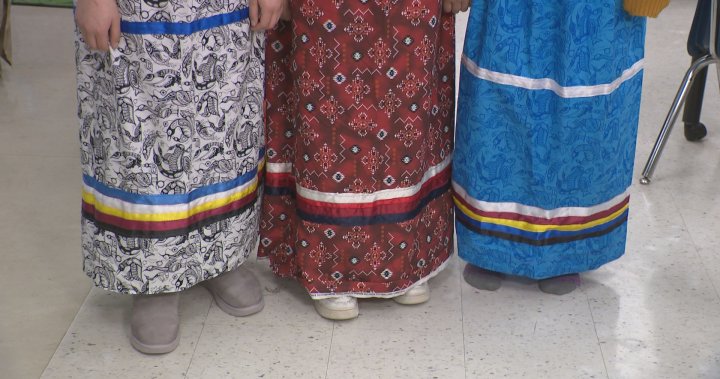Paragraph 1: The Genesis of a Movement
In 2020, a seemingly insignificant event in southern Saskatchewan ignited a powerful movement that resonated across Canada. A young Indigenous girl, adorned in her vibrant ribbon skirt, a symbol of cultural pride and identity, was subjected to shaming and disapproval at her school’s formal day. This act of disrespect, though seemingly isolated, exposed a deeper wound within Canadian society – a lack of understanding and appreciation for Indigenous traditions and the ongoing struggle for reconciliation. The incident quickly gained national attention, sparking outrage and prompting calls for greater cultural sensitivity and education. It became a catalyst for dialogue about the importance of respecting Indigenous cultural expression and recognizing the enduring resilience of Indigenous communities.
Paragraph 2: National Ribbon Skirt Day: A Symbol of Reclamation and Pride
The incident involving the young girl became a turning point, giving rise to the establishment of National Ribbon Skirt Day on January 4th. This day serves as a powerful reminder of the importance of reclaiming and celebrating Indigenous cultural identity. The ribbon skirt, far from being merely an article of clothing, is a symbol rich with meaning, representing connection to ancestral heritage, resilience in the face of adversity, and the enduring strength of Indigenous women. National Ribbon Skirt Day provides an opportunity for Indigenous communities to proudly display their cultural heritage, to share their stories and traditions, and to educate others about the significance of the ribbon skirt and its role in their cultural identity. It is a day to honor the past, celebrate the present, and envision a future where Indigenous cultures are embraced and respected.
Paragraph 3: Weaving a Tapestry of Empowerment: Saskatchewan’s Ribbon Skirt Initiative
In the wake of the incident and the establishment of National Ribbon Skirt Day, communities across Canada sought ways to express solidarity and promote greater understanding of Indigenous culture. One Saskatchewan community took a particularly proactive approach, embarking on a journey of cultural reclamation and empowerment by learning to create their own ribbon skirts. This initiative provided a tangible and meaningful way for community members to connect with their heritage, learn traditional crafting techniques, and express their individual and collective identities. The act of making ribbon skirts became a powerful symbol of resilience, a testament to the community’s commitment to preserving and celebrating its cultural heritage.
Paragraph 4: Beyond the Threads: The Significance of Ribbon Skirts
Ribbon skirts are more than just garments; they are intricate works of art, imbued with deep cultural and spiritual significance. Each skirt is a unique expression of the wearer’s identity, often incorporating colors, patterns, and embellishments that reflect personal stories, family histories, and connections to the land and ancestors. The process of creating a ribbon skirt is often a communal activity, bringing together generations of women to share knowledge, stories, and laughter. This intergenerational connection strengthens cultural bonds and ensures the continuation of traditional practices. The ribbons themselves often hold symbolic meaning, representing elements of nature, personal qualities, or significant life events. For Indigenous women, wearing a ribbon skirt is a powerful affirmation of their identity, a visible expression of their pride in their heritage, and a connection to their ancestors.
Paragraph 5: Sharing Stories Through Visual Media: Global News’ Coverage
Global News reporter Sarah Jones recognized the importance of sharing this inspiring story with a wider audience. Her report, featuring interviews with community members and footage of the ribbon skirt making process, provided a glimpse into the heart of this empowering initiative. By showcasing the vibrant colors, the intricate details, and the profound meaning behind the ribbon skirts, Jones’ report helped to bridge cultural divides and foster greater understanding and appreciation for Indigenous traditions. The video report, readily accessible online, provided a powerful visual narrative that conveyed the emotion and significance of this cultural revival, bringing the story to life for viewers across Canada and beyond.
Paragraph 6: A Ripple Effect of Change: The Ongoing Journey of Reconciliation
The story of the young girl in Saskatchewan and the subsequent rise of National Ribbon Skirt Day serves as a powerful reminder of the ongoing journey of reconciliation in Canada. While the incident highlighted the persistence of ignorance and prejudice, it also sparked a wave of positive change. The establishment of National Ribbon Skirt Day, the community initiatives focused on creating ribbon skirts, and the media coverage that amplified these stories all contribute to a broader conversation about cultural respect, understanding, and reconciliation. The ripple effect of this single event continues to spread, inspiring individuals and communities to embrace diversity, challenge stereotypes, and work towards a future where all cultures are celebrated and valued. The ribbon skirt, once a source of shame and misunderstanding, has become a powerful symbol of resilience, pride, and the ongoing journey towards a more just and equitable future for Indigenous peoples in Canada.

